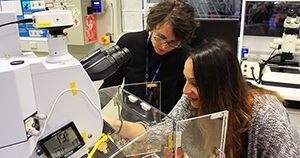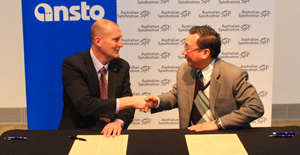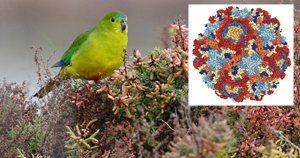- Details
Associate Professor Natalie Sims, leader of the research team, with Christina Vrahnas, first author on the Bone journal paper.
Melbourne researchers have used the Australian Synchrotron to reveal how bone made in people taking hormone treatment for advanced osteoporosis is likely to be stronger and more durable than previously thought, offering new insights into skeletal diseases and ways of predicting who may be at risk of fractures and breaks.
The experimental technique, developed by researchers from St Vincent’s Institute of Medical Research (SVI) in Melbourne and revealed online in Bone ahead of appearing in the December edition, uses infrared synchrotron light to monitor tiny sections of newly-formed bone at different times, in conditions mimicking the human body, influenced by parathyroid hormone treatment (PTH) or teriparatide.
SVI’s Associate Professor Natalie Sims, leader of the research team, says PTH is one of very few recommended second-line treatments for people with serious bone diseases, including osteoporosis.
‘PTH stimulates the production of new bone when bone fragility persists after first-line treatments fail, but previous studies suggested this replacement bone was not as strong as existing bone which, in turn, was thought to be behind ongoing fractures and breaks in people who had daily PTH injections.
‘Not only has our analysis shown replacement bone has exactly the composition and structure that it should, our investigative technique opens the door to previously impossible bone examination, which could shed new light on all skeletal diseases including osteogenesis imperfecta and osteomalacia.’
Associate Professor Sims says using the Australian Synchrotron, landmark research infrastructure of the Australian Nuclear Science and Technology Organisation (ANSTO), gave the research team new appreciation of how bones regrow, in unprecedented detail and accuracy.
‘When bone forms, collagen is laid down in a matrix, in which calcium builds over time in a process called mineralisation – it is crucial that we can probe deep into the bone matrix because on the surface, just like wood, both weak and strong bone can look exactly the same.
‘Moreover, the ability to analyse tiny bone sections only 15 microns across – about the size of two blood cells – meant we could go deeper and deeper into older and older bone in tiny increments, to identify structural differences: clues as to which bone was truly strong and which was truly weak.’
Professor Peter Ebeling AO, Head, Department of Medicine, Monash University at Monash Health says the new avenue of bone research could lead to improved diagnostic tests and approaches to predicting breaks and fractures.
‘Current bone density tests are quite good at telling us who is at most risk of fractures but, in many cases, they do not tell the full story.
‘By looking at tiny samples, as opposed to centimetres-long bone sections, it will be tremendous if this research can help inform a more precise and useful approach, as well as assisting with testing the efficacy of future, improved bone disease drugs that are able to build new bone.’
Media coverage
- 'Useful break in bone study', Herald Sun, Friday 28 October 2016
- Details
Professor Andrew Peele, Director of the Australian Synchrotron and Dr Sarawut Sujitjorn, Director of the Synchrotron Light Research Institute of Thailand, at Clayton in Victoria.
A new era of regional scientific cooperation begun this week with the signing of a Memorandum of Understanding (MoU) in Clayton between the Australian Synchrotron and the Synchrotron Light Research Institute (SLRI) of Thailand.
Over a two-day visit, which involved a tour of the Imaging and Medical Beamline (IMBL), roundtable discussions and an official dinner, executive board members of SLRI learned about the history, operations and future of the Australian Synchrotron, which will inform the development of the 1.2 GeV Siam Photon Laboratory (SPL), the first synchrotron facility in Thailand.
Discussions covered approaches to safety and risk, plans for expansion and business development and the broad range of supporting services ensuring the landmark ANSTO research infrastructure continues to go from strength to strength.
Future cooperation enabled by the MoU could involve the sharing of brainpower and expertise, as the Thai delegation expressed a desire to cooperate on a staff exchange program with the Australian Synchrotron.
- Details
Experts estimate less than 30 Orange-bellied Parrots remain in the wild. Researchers from Charles Sturt University have partnered with scientists from the Australian Synchrotron to reconstruct the outer shell of a beak and feather disease (BFD) virus cell (inset), which is threatening four species of endangered Australian parrot.
Australian researchers have unravelled the molecular makeup of a virus threatening some of the world’s most endangered species, paving the way for the potential development of a vaccine to save dwindling populations of the Australian birds.
The research, led by Charles Sturt University (CSU) scientists and published in the prestigious international journal Nature Communications overnight, revealed the structure of the smallest self-replicating virus behind the beak and feather disease (BFD).
The virus causes a debilitating disease affecting four rare species of native parrot, including the Western ground and Orange-bellied Parrots (pictured, above), of which less than 50 remain in the wild.
CSU Professor in Biochemistry Jade Forwood said, ‘We now have a unique way of thinking about the virus and how it self-assembles. We know at the atomic level, the structure of the virus and how it fits together.’
CSU Professor in Veterinary Pathobiology Shane Raidal said, ‘The finding is significant because, by confirming how the viral structure forms, we can begin to develop a vaccine to interrupt these processes.’
The BFD virus programs only two proteins to drive its replication and spread: one to assist the reproduction of the viral DNA, and one to construct the outer shell of the virus. This shell is built from 60 individual capsid proteins that self-assemble and fit together in a highly specific and ordered arrangement around the viral DNA.
The outcomes of this research provide the atomic coordinates of approximately 200,000 atoms which make up the virus, and insights into how the viral DNA can bind to the shell, ensuring the protection and delivery of the viral DNA.
At the Australian Synchrotron in Melbourne, landmark research infrastructure of the Australian Nuclear Science and Technology Organisation (ANSTO), the Micro Crystallography (MX2) beamline produced X-rays more than a million times brighter than the sun to create intricate diffraction patterns as light bounced off microscopic crystals of the viral capsid proteins. This allowed the researchers to identify the locations of the individual atoms and broader structure of the viral shells in stunning 3D detail.
The research team, involving scientists from CSU, Monash University, the Australian Synchrotron, and Spain’s National Microbiology Centre and the Autonomous University of Madrid, have been working on the project since 2009.
Along with the loss of habitat and feral predators, the BFD virus is one of the main threats to the affected parrots, which also include the Norfolk Parakeet (Norfolk Island) and the Swift Parrot (eastern and southern states). Infected birds face starvation and death as their feathers moult and their beaks soften.
Professor Raidal said, ‘The disease has caused significant problems, in particular, for the Orange-bellied Parrot since 2006 when it reappeared in the captive recovery program.
‘The Parrot is a small and vulnerable migratory bird which breeds only on Tasmania’s south-west coast, flying north to spend the winter in coastal Victoria and South Australia, so we look forward to building on this work to find new approaches to restoring their numbers in the wild.’
Mr Barry Baker, Chair of the national Orange-bellied Parrot Recovery Team said it is important new and innovative fields of science work across conservation projects to protect Australia’s at-risk fauna.
‘BFDV is an awful disease, especially in small, short-lived species like Orange-bellied Parrots – young birds with the virus stand little chance of survival in the wild, and affected captive birds are often compromised, as the virus can affect the bird’s ability to fight off other health issues.
‘Although recent Orange-bellied Parrot recovery efforts have proven effective, in 2014 the wild population suffered from a spillover of BFDV (from another wild species) and we believe there are currently less than 30 birds out there – another outbreak of the disease in the wild would be a disaster, so the ability to vaccinate would be a leap forward in parrot conservation, also benefitting captive populations and our ability to release to the wild.’
Media coverage
- 'New weapon against virus killing Australia's endangered parrots', Australian Geographic, Thursday 6 October 2016
- 'Aus researchers’ bird virus breakthrough' on Nine News online, Wednesday 5 October 2016



